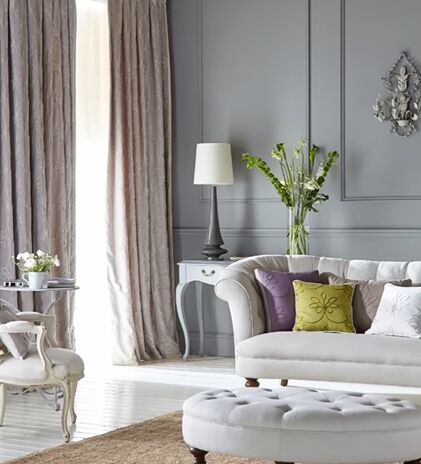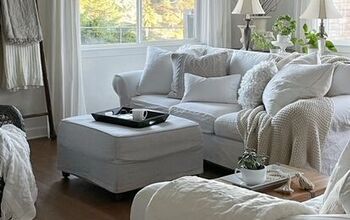9 Living Room Mistakes to Avoid & What to Do Instead

Let's talk about 9 living room mistakes to avoid when designing a new space and what to do instead to create a comfortable, cohesive, and inviting atmosphere.
Of all the rooms in our homes, living spaces are the ones where we spend the most waking hours so how these rooms look and function is essential to our comfort and well-being. There are a few missteps that tend to affect living spaces more than any other, so we're going to break them down by broad categories of comfort, proportion, and scale.
Becoming familiar with common living room layout mistakes will help you transform your space into something much better than you could have dreamed of.
Living room mistakes
1. Not considering function and layout
The first thing to consider is the layout and making sure that it supports all the activities of the space. Arranging furniture pieces around a focal point at a conversation-friendly distance is a great way to do this.
A common mistake is to spread the seating too far apart, lining furniture pieces up against the wall.
Instead, float your furniture pieces on an ample area rug around that focal point.
2. Prioritizing looks over comfort
You may be attracted to certain looks in seating, like curved shapes, leather, and button tufting. While these features may look great, it's important to evaluate them in the context of the comfort level you need.
If the primary purpose of the space is mainly decorative, which could be the case if you have a formal living room, then shapes conducive to lounging, cozy fabrics, and soft cushioning might not be as important as they would be in a space like a family room.
3. Placing the television too high
Placing your TV too high, like over a mantle, puts stress on your neck and makes viewing uncomfortable. The recommended height is 42 inches or about 107 centimeters to the center of the screen, which will be at about eye level if you're seated and will be the most comfortable angle.
If your TV must share a space with your fireplace, moving it off to one side can be a good solution.
4. Having too few tables
Having too few tables will leave you and your guests without anywhere to place a book, a drink, or snacks.
A coffee table, in particular, is a great place to create vignettes with your decor items, or it can even double as storage.
You can always consider smaller seat tables or drink tables that will make the space more comfortable for you and your guests.
5. Having bad lighting
Using only overhead lighting can make a room feel cold and harsh and cast unflattering shadows.
By layering in ambient lighting, like wall lights and lamps, you'll give your space a cozy and relaxed feel.
If you need to have direct overhead lighting, put it on dimmers to give yourself some flexibility and combine it with floor lamps, table lamps, and sconces for more visual comfort and a softer look.
In addition, keeping the color temperature of the lighting in your living space on the warmer side at 2700 Kelvin will make the room feel cozy and intimate.
6. No height variations
The scale of furniture and furnishings and how they work together is important in creating balance and interest. Furniture and decor that's placed all at one level makes a space look flat and uninteresting.
Create visual interest by varying heights around your living space and balancing proportions to each other.
7. Having unbalanced proportions
Make sure your furniture pieces are in proportion to each other. A good guideline is to follow the 2/3rds rule. For the living room, look for a coffee table that's about 2/3s the length of the sofa.
You can also group smaller tables of different heights to get the dimensions right.
Use the same approach for displaying artwork. The guideline here is the same as for the sofa coffee table arrangement.
If you're hanging the piece over a sofa, mantle, or console table, aim for the piece or group of smaller pieces to be at least 2/3rds the length of the furniture piece, wall, mantel, or whatever it's hanging over to keep everything in proportion.
And a little bonus tip on artwork is to keep it at about 57 inches high on center, which is a comfortable viewing height for most people.
8. Having too small of an area rug
An area rug helps ground and define a room and adds depth and texture, but if it's too small, it'll break up the flow of the space and make the room appear smaller.
A larger rug will anchor the space and offer unity for all the pieces within the space. Ideally, all the pieces in the living room would fit on top of the rug, but at minimum, the rug needs to be big enough to fit at least all the front legs of the seating, plus at least 8 inches on the sides.
9. Not thinking in layers
One of the biggest design mistakes is not thinking in layers.
A first layer could be rugs and draperies, something to soften the hardness of floors and walls.
Next, bring in your comfy furniture to create your conversation-friendly seating layout.
Then comes the most fun part, accessorize. Lamps, pillows, throws, pottery, plants, and artwork are the items that reflect your style and personality and help create the cozy layered look.
Living room mistakes
Let me know in the comments what you think about my tips for correcting living room mistakes. It is not always easy to see the decorating mistakes in your living room at first glance, but once you become more familiar with them, it becomes impossible not to see them over time.
Ready to correct the worst living room design in your home? There’s no time like the present to get started.
Featured products
- IKEA SIMRISHAMN floor lamp
- IKEA EVEDAL table lamp
- Pottery Barn Shay Woven Leather Chair
- Pottery Barn Delaney Oval Marble C-Table
- Rejuvenation Jute Braided Pouf
- West Elm Sintra Metal Coffee Tables
- West Elm Industrial Storage Pop-Up Coffee Table
- West Elm Mid-Century Drink Table
- WS Home Lisbon Rectangular Coffee Table
- WS Home Artwork Graphite Grid Series
Living room inspiration
- Lulu and Georgia
- Chicology (shades and blinds)
- Pottery Barn
- West Elm












































Comments
Join the conversation